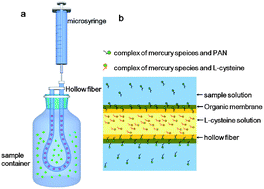An improved hollow fiber supported liquid–liquid–liquid membrane microextraction (HF-LLLMME) method is described for the simultaneous extraction of inorganic and organic mercury species with high efficiency prior to speciation analysis by capillary electrophoresis. The HF-LLLMME was developed by filling cyclohexane and L-cysteine aqueous solution in the pores of the hollow fiber wall and its lumen as organic liquid membrane and acceptor phase, respectively. Inorganic mercury (Hg2+), methylmercury (MeHg), ethylmercury (EtHg) and phenylmercury (PhHg) firstly formed hydrophobic complexes with 1-(2-pyridylazo)-2-naphthol in donor solutions, wherein the hollow fiber was immersed. The complexes were then extracted into the organic liquid membrane and further transferred into the lumen of the hollow fiber to form hydrophilic complexes with L-cysteine. The factors affecting the extraction efficiency were carefully investigated. With the consumption of 50 mL of sample solution, the enrichment factor was 103, 265, 511 and 683 for Hg2+, MeHg, EtHg and PhHg, respectively. The limits of detection were in the range of 0.07–1.0 ng mL−1 (as Hg) with precisions (RSDs, n = 6) ranging from 1.7 to 4.4%. The proposed method was validated by analyzing a certified reference material (DORM-2, dogfish-muscle) and an environmental water sample with satisfactory results.

You have access to this article
 Please wait while we load your content...
Something went wrong. Try again?
Please wait while we load your content...
Something went wrong. Try again?


 Please wait while we load your content...
Please wait while we load your content...